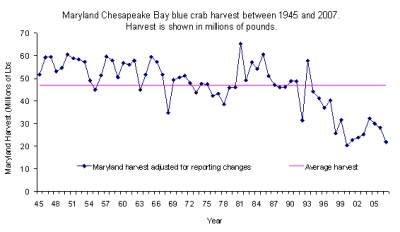
Annual blue crab harvest chart shows that 2007 was one of the worst years in history. An overall downward trend began in the late 1980s.
ANNAPOLIS (Feb. 4, 2008)—The Maryland Department of Natural Resources (DNR) Fisheries Service today presented the estimated 2007 blue crab harvest numbers from Maryland’s portion of the Chesapeake Bay. The estimated 2007 harvest is 21.8 million pounds, approximately 6 million pounds below last year’s harvest and slightly above Maryland’s lowest recorded harvest of 20.2 million pounds in 2000.
“The low 2007 blue crab harvest is the result of many factors including: low abundance due to poor reproduction of young blue crabs in late 2006; reduced fishing effort; and unusual climatic conditions that caused blue crabs to move further north up the Bay’s tributaries, making them less accessible to large crab pot fishing operations,” explained DNR Fisheries Biologist Lynn Fegley.
Expressing concern over the numbers, Governor Martin O’Malley directed DNR to begin developing a series of management options in consultation with stakeholders. Maryland has already initiated discussions with Virginia and the Potomac River Fisheries Commission to ensure coordination of possible management actions.
“Since 70 percent of the Bay’s female blue crabs are harvested from Virginia waters, we must work together to coordinate action toward a solution,” said DNR Secretary John Griffin, “and both states must enforce their fair share of any necessary restrictions if we are to ensure the future of our blue crab population.”
Maryland will rely on scientists’ feedback and assessment of the relative effects of management options on the blue crab population numbers prior to implementing any restrictions, which could occur as early as April 2008.
The Bay-wide blue crab winter dredge survey, currently underway in a cooperative effort by DNR and the Virginia Institute of Marine Science, will offer a more complete picture of blue crab population numbers once completed later this spring. Since 1990, the survey has employed dredges to sample blue crabs at 1,500 sites throughout the Chesapeake Bay from December through March. By sampling during winter when blue crabs are buried in the mud and stationary, scientists can precisely estimate the number of crabs in the Bay. Results of the 2008 blue crab winter dredge survey will provide the basis for potential management actions in 2008 and beyond.
“Recently, the blue crab has been in the headlines because of reduced catches by commercial and recreational crabbers in the Bay,” said DNR Assistant Secretary for Aquatic Resources, Frank Dawson. ” While harvesting is a major factor in affecting the crab population, impaired habitat—particularly the loss of bay grasses due to poor water quality—has also significantly contributed to the problems facing our state’s treasured blue crabs.”
“Every Maryland citizen and business has a role in helping to protect our blue crabs and restore the Chesapeake,” added Secretary Griffin, “and we all need to start taking actions in our daily lives to live more sustainably, to ensure a healthy future for our blue crabs, our children and our beloved Bay.”
For more information on what citizens and business can do to help protect blue crabs and the Chesapeake Bay visit http://www.dnr.state.md.us/bay/tribstrat/index.html.
Source: Maryland Department of Natural Resources (DNR)


